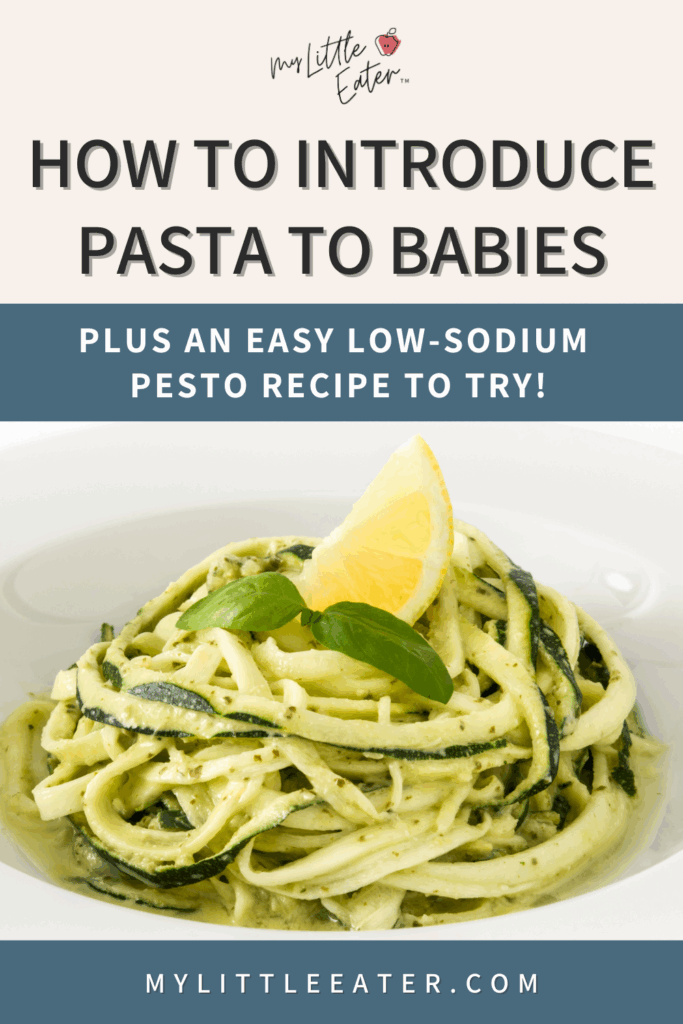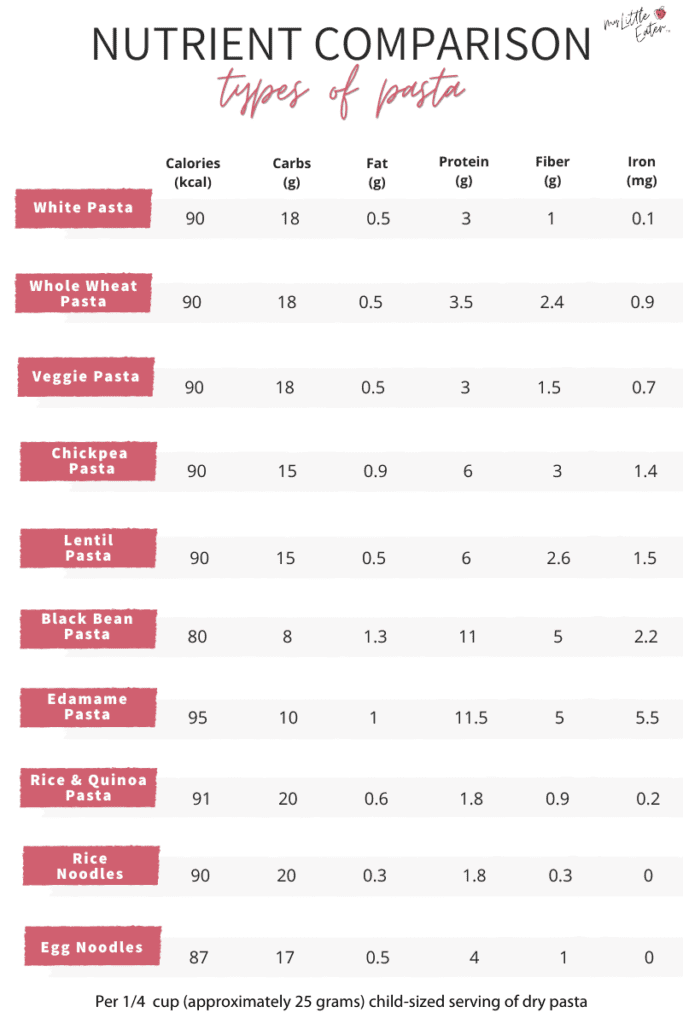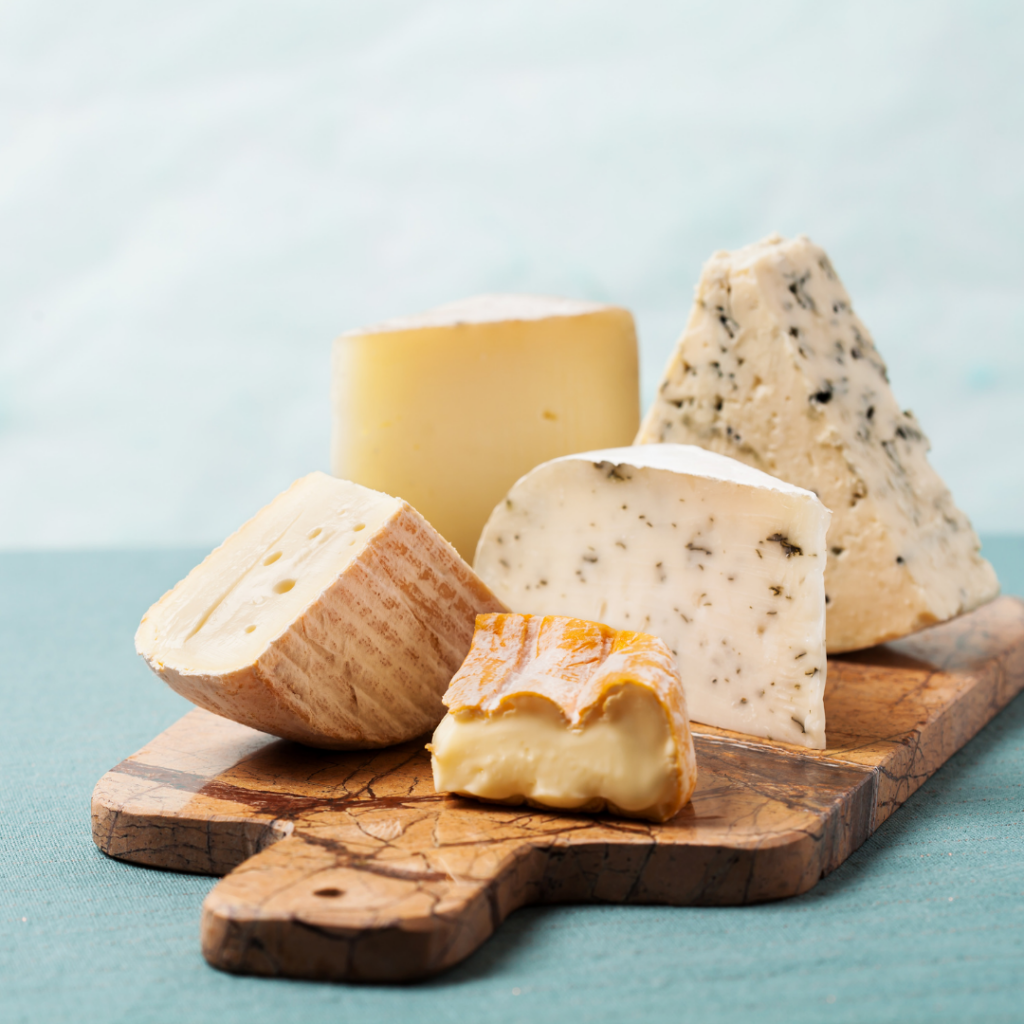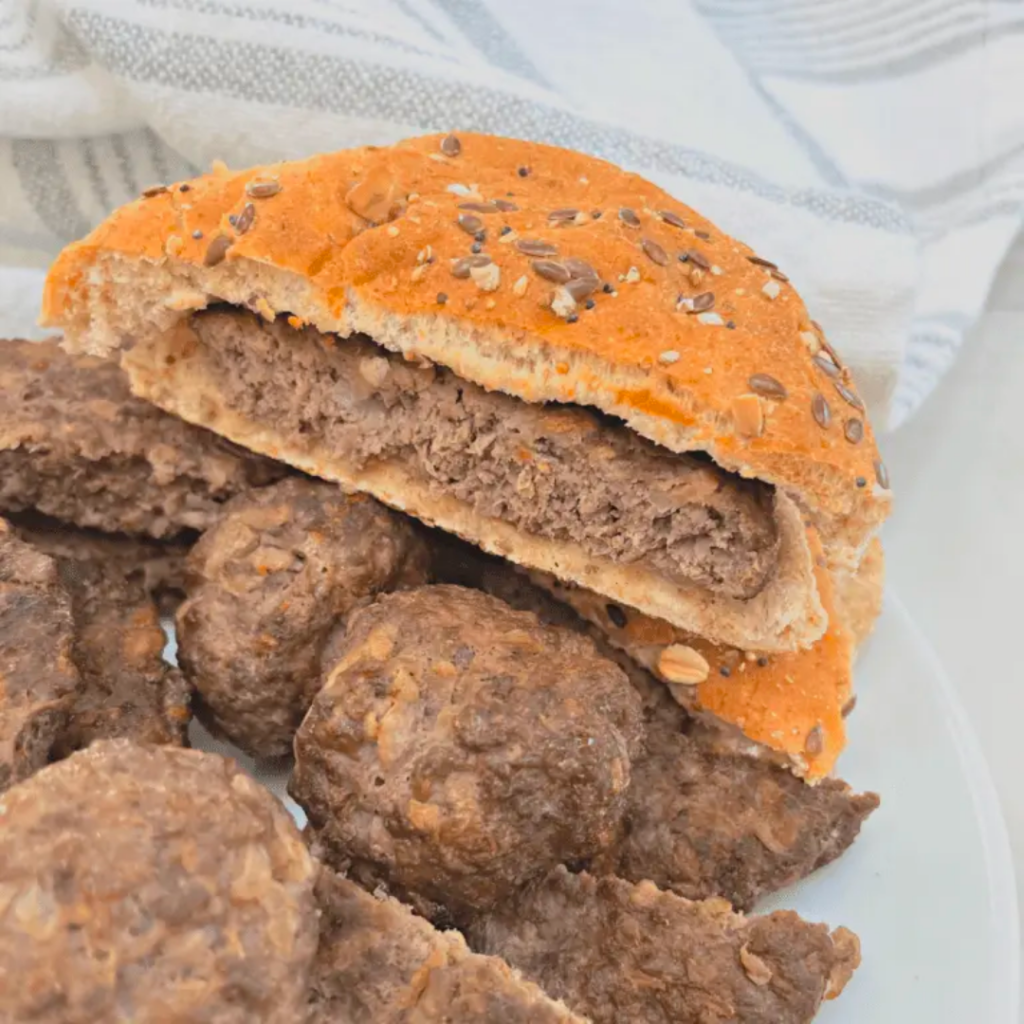- Published: February 12, 2024
- No Comments
- Chelsey Landry, RD, Bianca Gruenewald, RD, & Mallory Roberts, SLP
- Updated: May 6, 2025
This post may contain affiliate links, please view our disclosure policy for more details.
Pasta is a popular dish that originates from Italy, though noodles of other sorts are eaten all around the world and come in a variety of different shapes and sizes.
The best part? It’s easy to serve, affordable, and so versatile in how it can be prepared. Simply change the shape of the noodle, sauce, or ingredient combinations using different types of spices, vegetables, meat, and meat alternatives (like lentils or tofu), and you have a whole new dish!
When it comes to serving different pasta noodles to your baby, there are some things to consider…which pasta shape is best for babies, which shapes need to be avoided, how to cook and serve it safely, and what sauces to pair it with.
Let’s dive into the specifics of how we should be feeding babies pasta!
Table of Contents
If you’re feeling overwhelmed about starting solids and you’re not sure where to begin, join our FREE workshop – How to start solids: A realistic first week of feeding your baby. This workshop is for parents ready to feel confident and prepared to start solids—without all the guesswork.
Learn exactly what to feed, when to feed it, and how to do it—step-by-step—with expert guidance from pediatric dietitian, Edwena Kennedy. Plus, get a FREE 5 day meal plan just for attending!
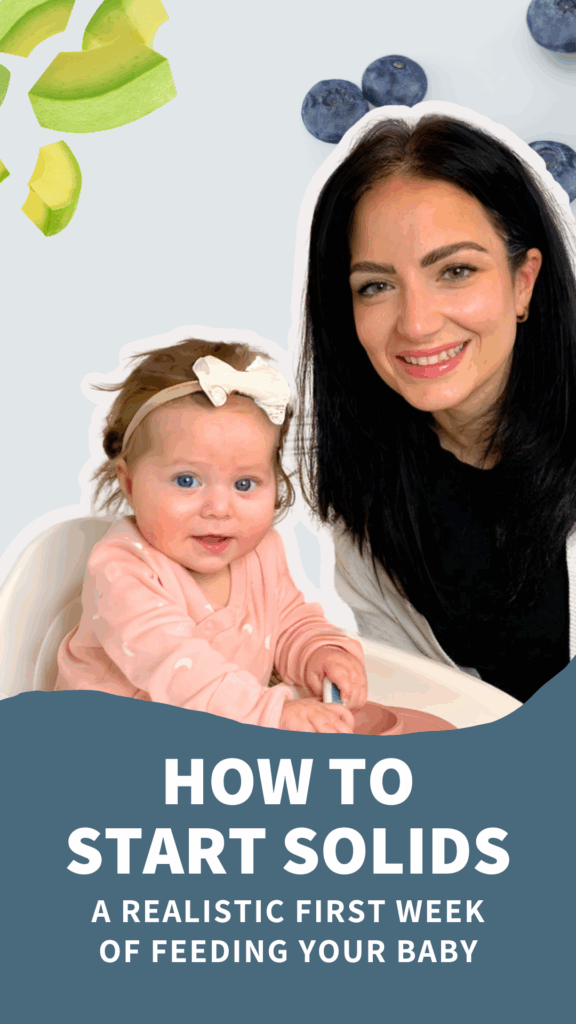
For ultimate confidence in how to feed your baby from 6-12 months of age, join our Baby Led Feeding Program! This expert-led, video-based course teaches you all about starting solids with the feeding method that’s best for you and your baby.
You’ll learn how to progress through a variety of textures in a timely way, prevent picky eating, serve all food safely, and raise a food-loving baby!
Plus, it includes our Texture Timeline™ video library! Easily search for any food and find a video for exactly how to serve it according to age and phase.
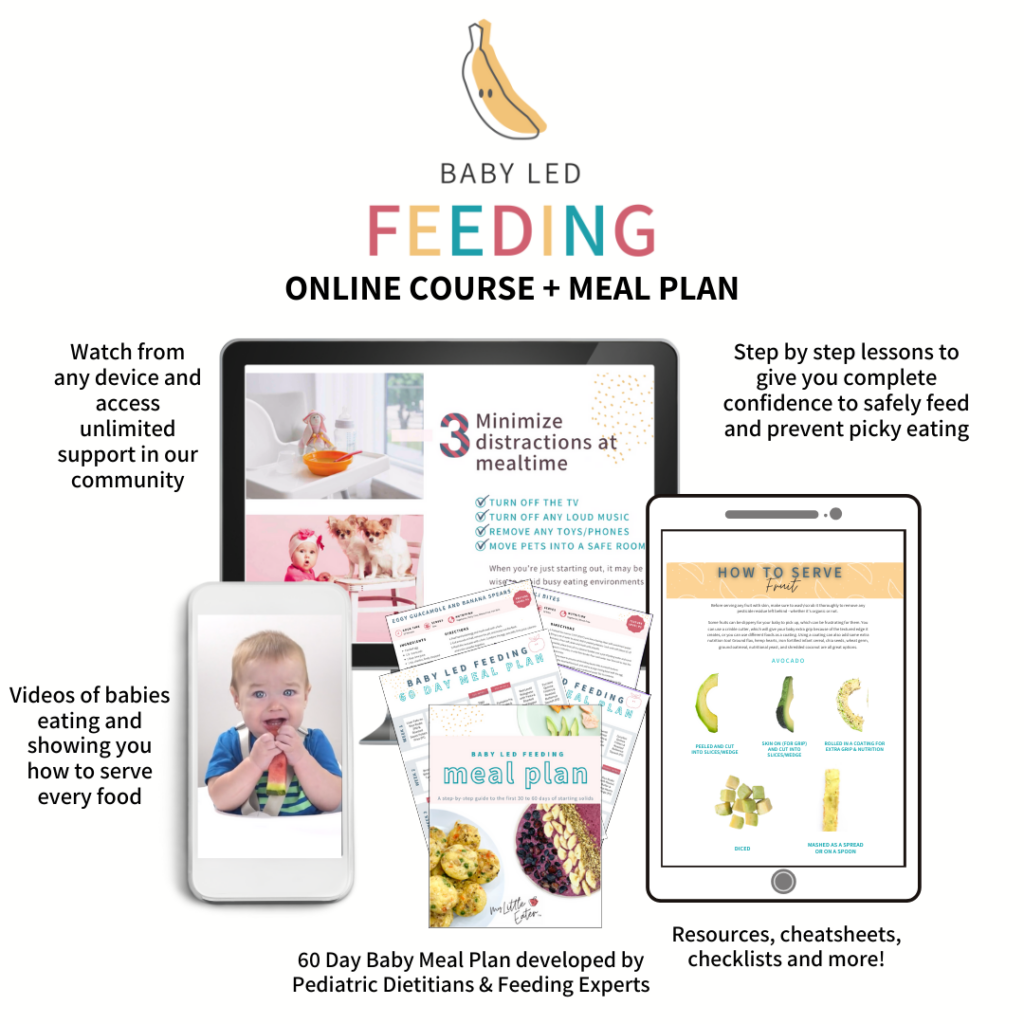
When can babies eat pasta noodles?
Pasta noodles can be introduced to babies when they start solids at around 6 months of age, when they show all of the developmental signs of readiness to start.
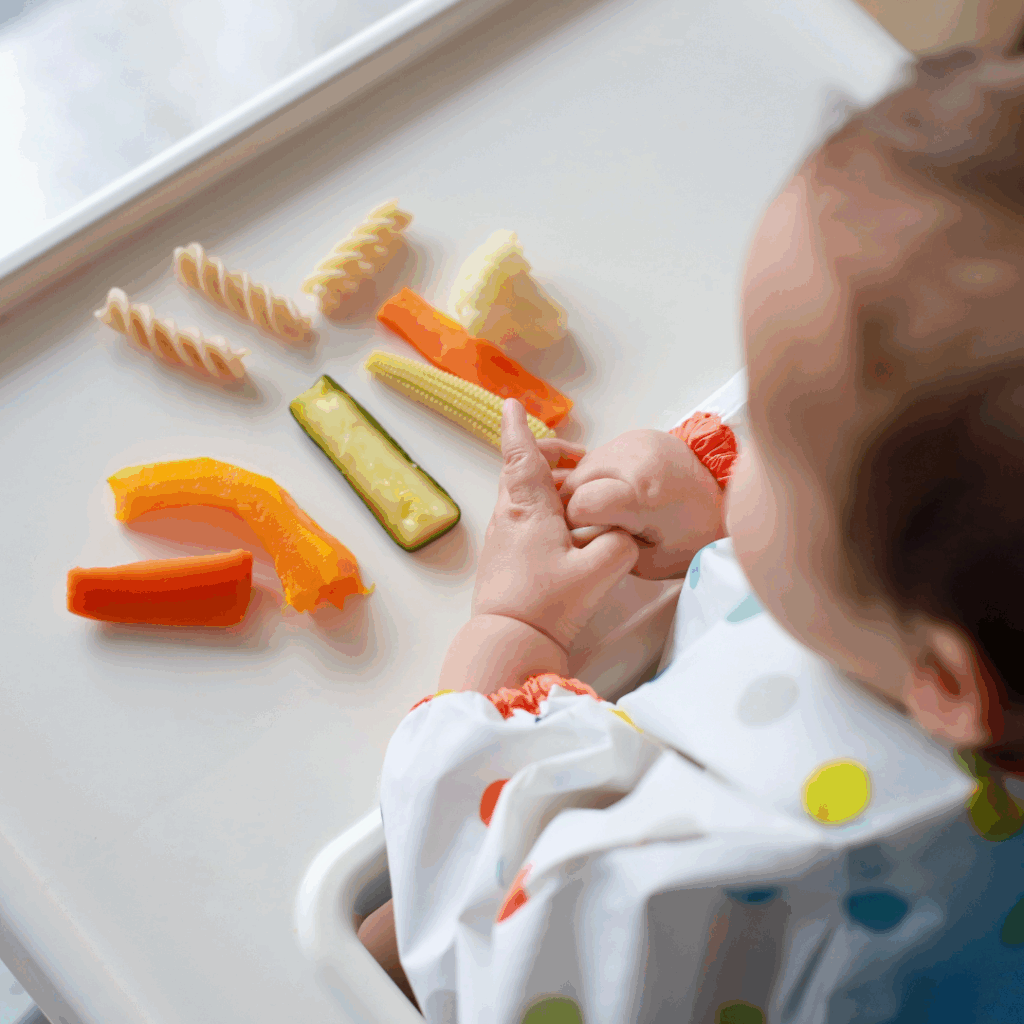
Watch this sweet baby eat noodles!
Watch this sweet baby eat noodles!
This baby is 11 months old and is self-feeding a bowl of rotini pasta.
Are pasta noodles a choking hazard for babies?
Pasta noodles aren’t considered to be a common choking hazard for babies. Once cooked, they become soft and easily squishable between your baby’s strong gums.
However, pasta noodles can cause babies to gag quite a bit, so to make it easier for your baby to swallow, serve them with sauce or a drizzle of olive oil instead of plain.
Always ensure you’re offering your baby appropriate foods based on their skill level and ability to chew their food thoroughly. Our signature Texture Timeline™ found in the Baby Led Feeding Program will help you determine what is safest for your baby.
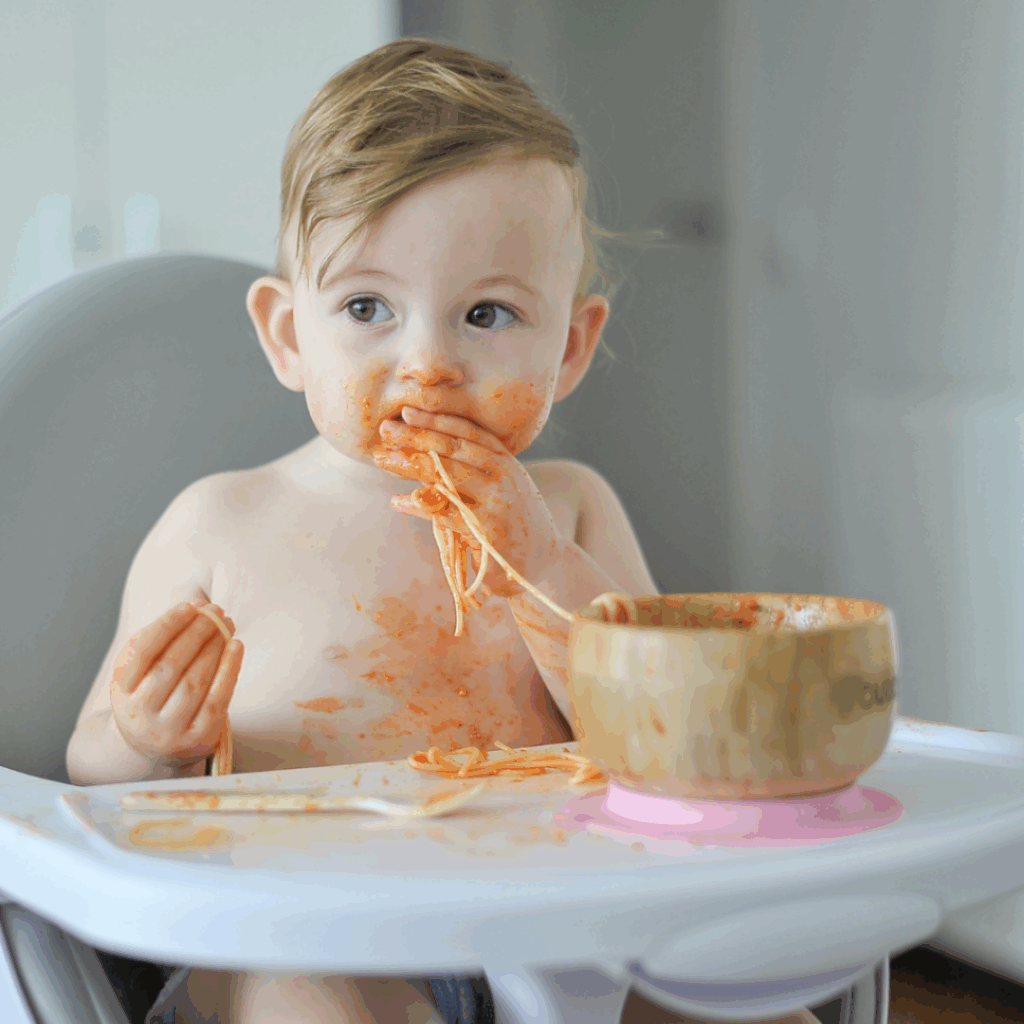
Safe pasta shapes for babies
With so many options available, we encourage you to switch up not only the pasta shape but also the types of pasta you offer. All pasta types are safe for babies, but be sure to look at the ingredients.
Sometimes more than one top allergen will be present, so you’ll need to ensure you’re following proper introduction protocols for allergens.
Fun fact
Fun fact
The International Pasta Organization believes that there are more than 600 different shapes of pasta produced around the world (3).
Pasta noodle shapes for palmar grasp (6M+)
Bigger is often better for babies who are just starting solids! Most pasta noodle shapes are safe to eat from a texture and shape perspective, but long, thin noodles like spaghetti will be harder for your baby to get in their mouth (in the beginning).
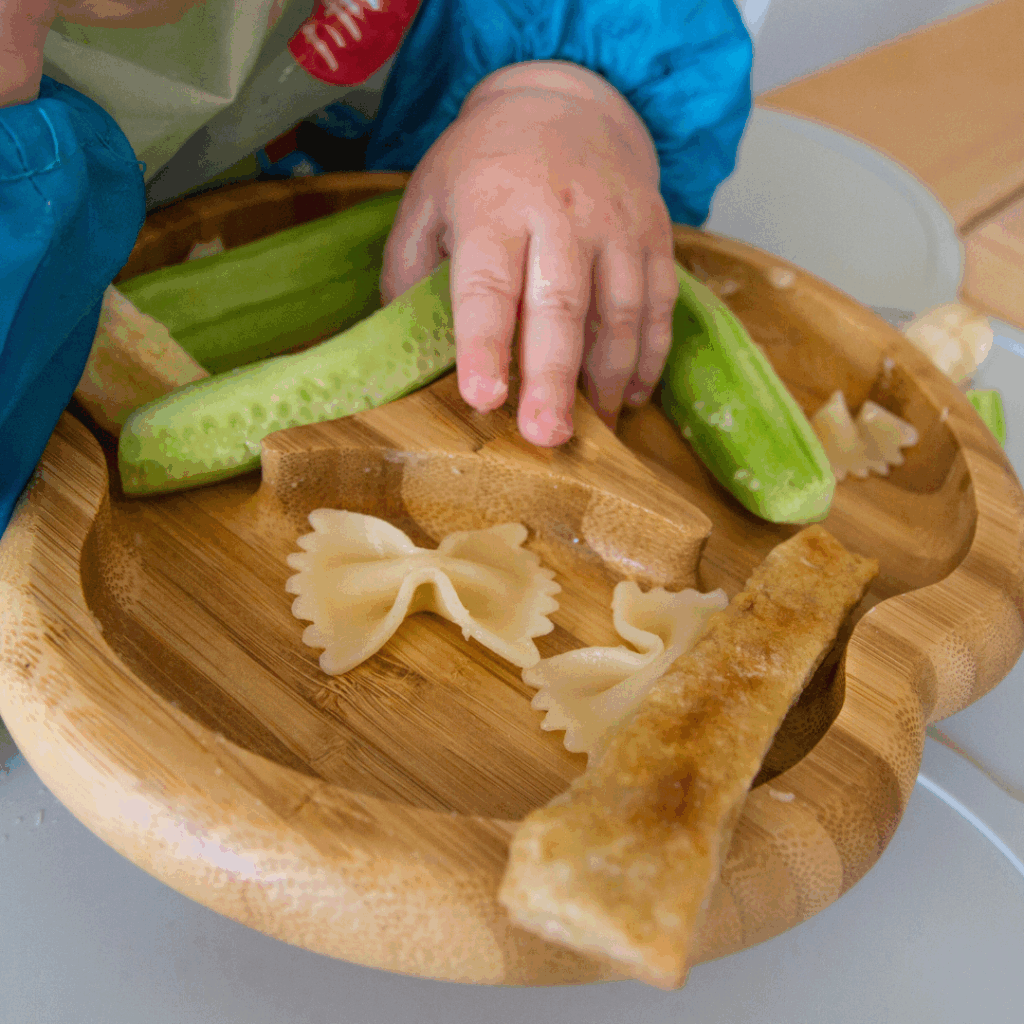
The best pasta shapes to start with, from approximately 6-8 months, include larger round or flat noodles like…
- Rotini
- Rigatoni
- Penne
- Large shells
- Lasagna (cut in quarters with sauce and rolled up)
- Wide egg noodles
These shapes, specifically rotini, rigatoni, and penne, will be easiest for your baby to hold with their palmar grasp and bring to their mouth to self-feed. Coat them in a bit of olive oil, tomato, marinara, or pesto to keep the pasta noodles moist and boost nutrition!
Spaghetti noodles are still ok from a safety perspective, so you can try serving them clumped up in a pile for your baby to grab with their palmar grasp. However, it will probably be more difficult for them to navigate getting the noodles into their mouth in the beginning.
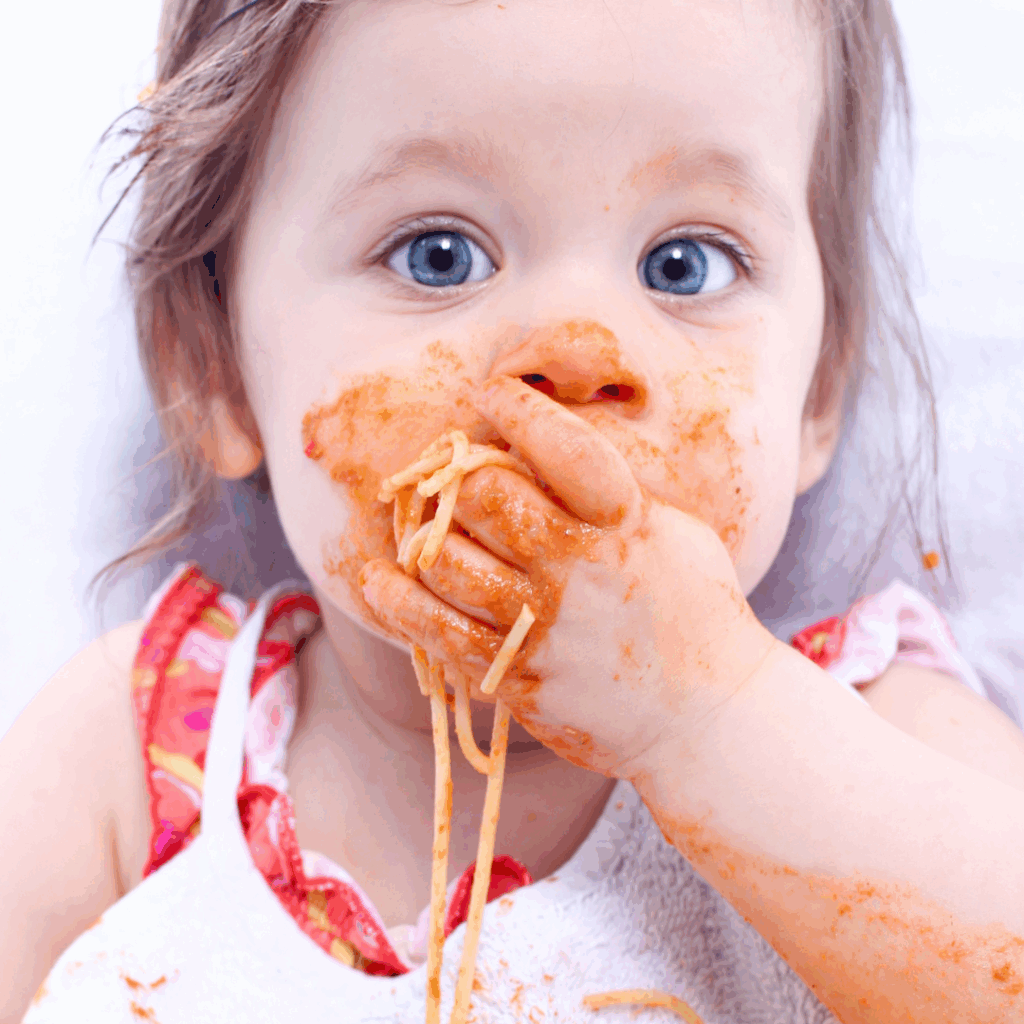
You can also try cutting them up and stacking the smaller pieces into a haystack for them to grab from using their palmar grasp. This will make it easier for your baby to hold on to some noodles and get them into their mouth.
Top tip
If your baby is struggling with how slippery the noodles are with sauce or oil on them, try sprinkling a bit of nutritional yeast on top for better grip (and added nutrition!).
Pasta noodle shapes for pincer grasp
(8-9M+)
Once your baby has developed their pincer grasp, around 8 to 9 months of age, you can start offering new pasta shapes like…
- Spaghetti
- Macaroni
- Orzo
- Gnocchi, and more!
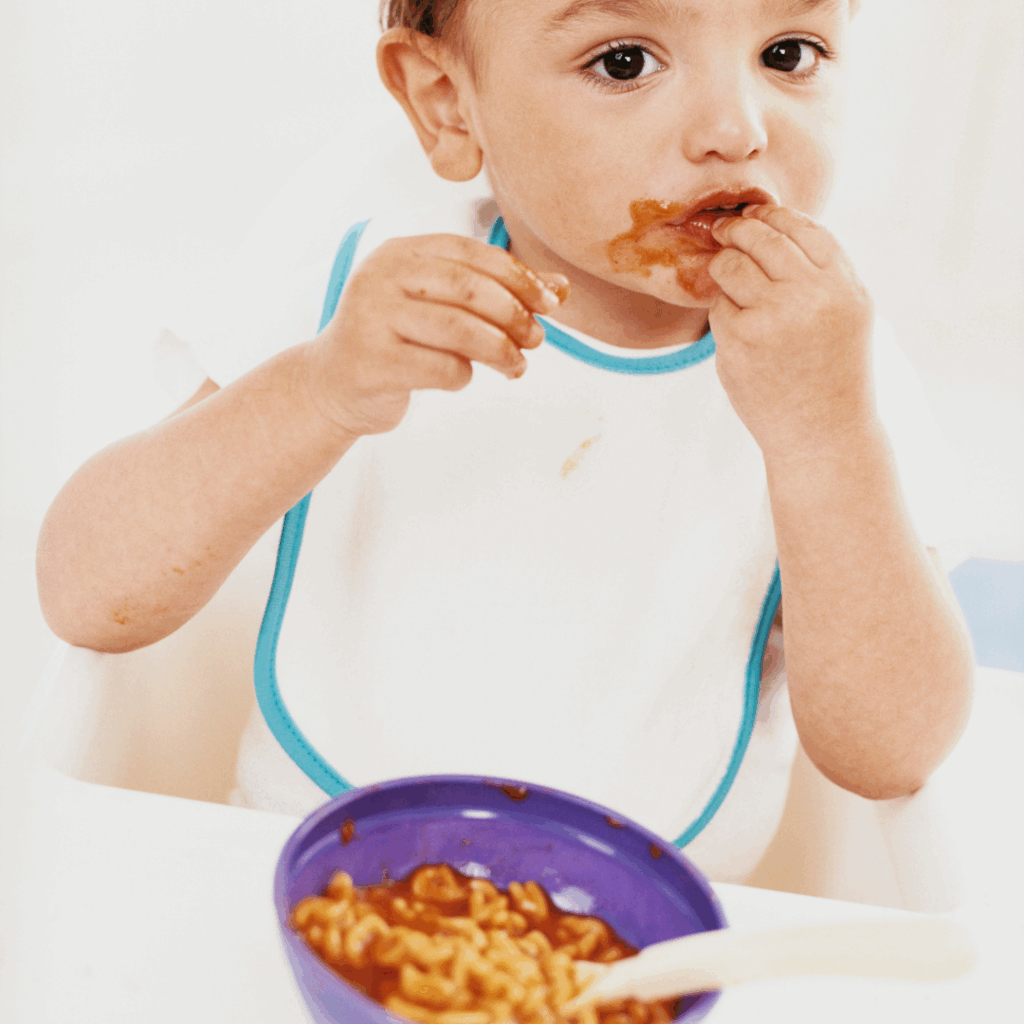
They can practice picking them up between their index finger and thumb and bringing them to their mouth.
However, you can and should still offer other pasta shapes like rotini, rigatoni, penne, lasagna, etc. You can modify them by cutting them into smaller bite-sized pieces so your baby can continue to practice using their pincer grasp, or offer them as they are for continued practice and variety.
Top tip
As we know, pasta with sauce can be slippery and might make these small noodles even harder for your baby to pick up.
If so, you can try serving sauce on the side and let them dip the plain pasta in the sauce instead!
Cooking pasta noodles for babies
When cooking pasta noodles for your baby, it’s important to achieve the right texture so that it’s not too gummy or undercooked to ensure it’s safe.
How long should you cook pasta to get the perfect texture? Well, there isn’t one simple answer, and the process will involve some taste testing!

Follow these steps when cooking your baby pasta (1):
- Choose a pot that is big enough to allow the pasta noodles to “swim” freely while cooking. Follow the package instructions for water-to-pasta ratios.
- Once the water comes to a boil, add a pinch of salt (avoid adding oil to pasta water as it will make the noodles slippery, and the sauce may not stick as well).
- Add pasta noodles to the boiling water and stir to ensure all the pieces of pasta are separated. You can start your timer when the water comes to a second full boil.
- If no time is given on the pasta package, follow these rules of thumb, but be careful to check the pasta often for doneness as it cooks:
– Fresh pasta: 3 to 5 minutes.
– Thin, dried durum wheat pasta (like spaghettini, shells, rotini): 6 to 9 minutes.
– Dried spaghetti: generally 8 to 9 minutes, depending on the brand and thickness.
– Thick, dried durum wheat pasta (like penne): 12 to 15 minutes. - A minute before the estimated pasta cooking time is up, remove a piece of the pasta to check for doneness. You want the pasta to be either al dente (soft exterior, slightly dense interior) or slightly softer. You don’t want soft, limp pasta. Bite the pasta to check. If you see a thin white line or white dot(s) in the middle of the pasta, it’s not done yet.
- Let the pasta noodles cook for one minute longer and test again. Repeat until you reach the desired texture.
How to serve pasta according to the Texture Timeline™
These are the safest, suggested ways to serve food to your baby based on the scientific, developmental, and clinical research and expertise available to date and are vetted by leading pediatric doctors, speech-language pathologists, and dietitians. However, please note that babies can technically choke on anything, including purees. Always take into account your child’s individual abilities and needs and check with your doctor or feeding therapist on the safety of offering these foods to your baby. Be mindful of how to set up a safe eating environment and please know that all material, opinions, advice, and information found on mylittleeater.com is for informational and educational purposes only. See our disclaimer for more information.
What is the Texture Timeline™?
A tool exclusive to My Little Eater that allows you to start solids with your baby using purées, finger foods, or a mixture of both. We sort all foods into different phases of the timeline based on texture difficulty, presenting multiple ways to serve each food depending on what you and your baby are ready for.
You can start with any phase of the Texture Timeline™. The goal is to always be moving forward on the timeline so that you can advance your baby to more challenging textures in a timely manner. This will allow your baby to develop and practice new eating skills and ensure that they don’t stay stuck on one texture for too long.
Using the Texture Timeline™ can help to prevent picky eating, all while keeping the feeding process enjoyable and less stressful for you because you can ease into the difficult textures that often cause more anxiety and worry.
Texture Timeline Phase 1
Mashed (mixed with sauce)
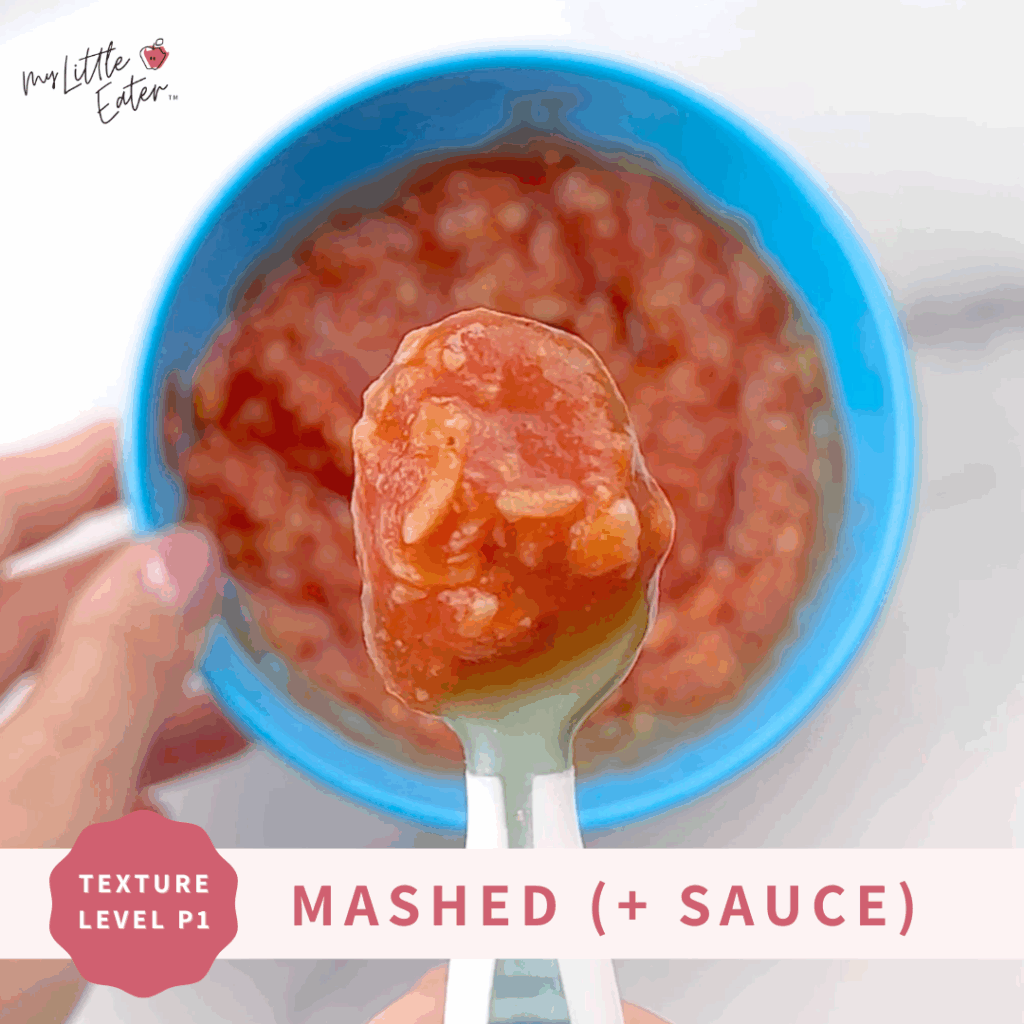
Mash cooked pasta with the back of a fork and serve it mixed into a puree or pasta sauce of your choice to add moisture to the pasta noodles. In this phase, it’s ok to serve your baby small, soft, lumpy textures.
Serve to baby on a preloaded spoon for them to self-feed, or you can spoon-feed it to them. If they aren’t interested in using a preloaded spoon, let them dig in with their hands!
Texture Timeline Phase 2
Medium-sized pasta noodles with sauce (Palmar Grasp)
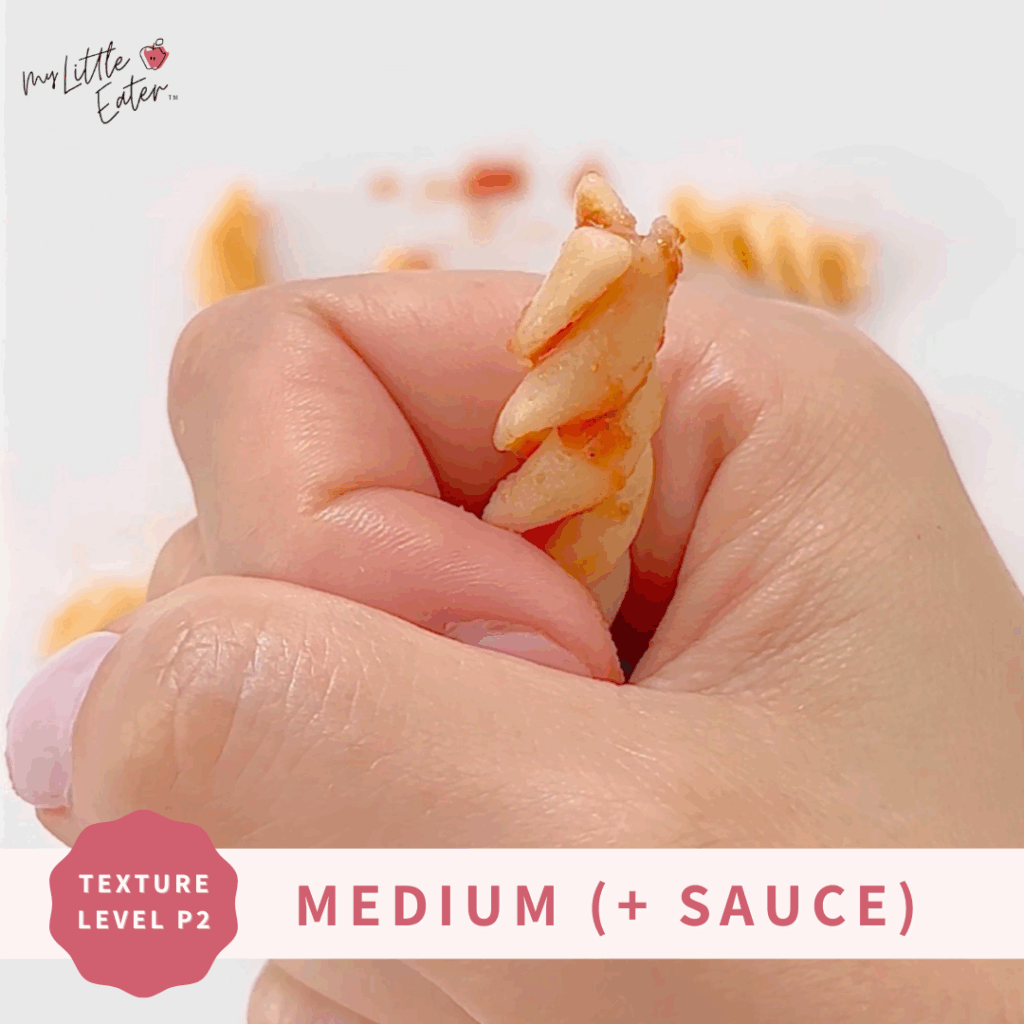
You can serve baby medium-sized pasta shapes like rotini, penne, or ziti that they can hold for self-feeding using their palmar grasp. Coat the cooked pasta noodles in oil, butter, or sauce to add moisture and make it easier for your baby to chew.
Texture Timeline Phase 2
Large-sized pasta noodles with sauce (Palmar Grasp)
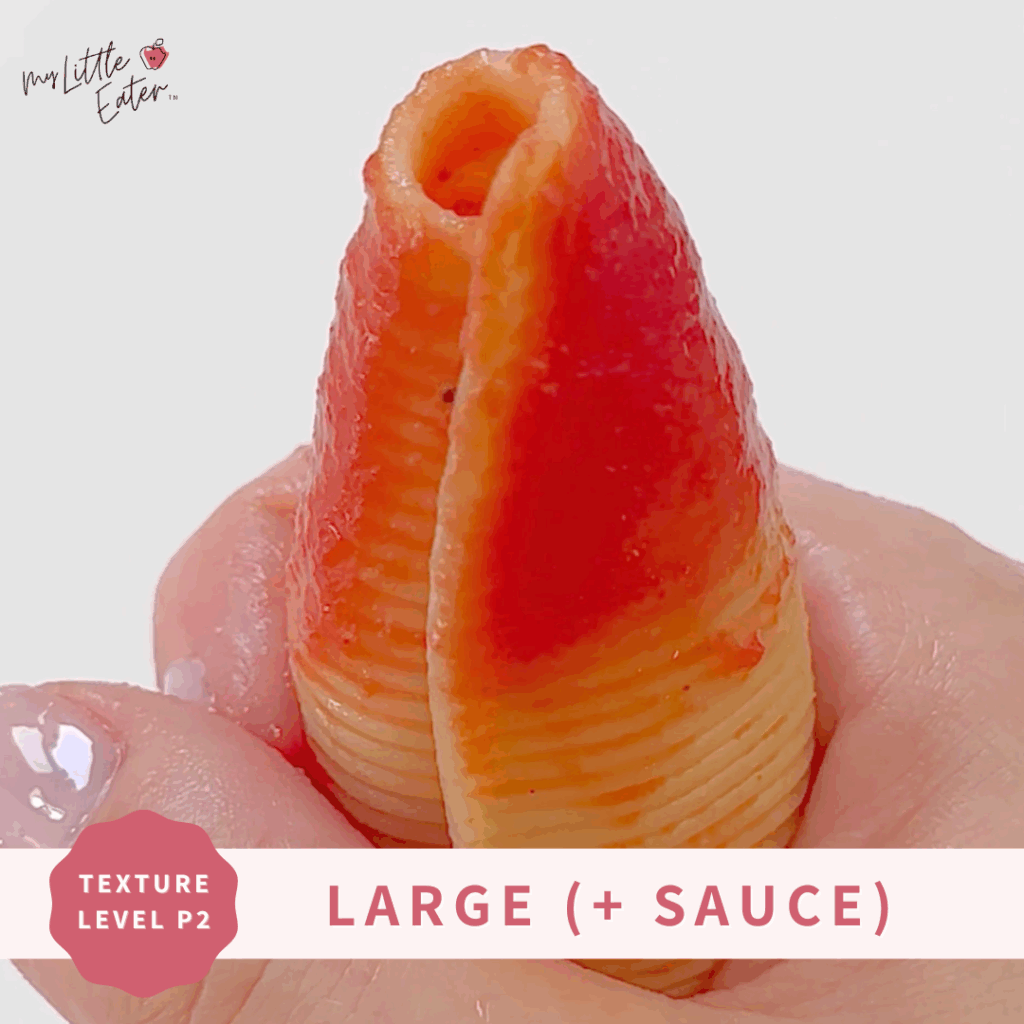
You can serve your baby large pasta shapes like jumbo pasta shells, cheese ravioli, or lasagna noodles that they can hold for self-feeding using their palmar grasp. Add sauce, butter, or oil to keep the pasta noodles moist and easy to chew. If serving lasagna noodles, cut them vertically to be approximately 2 finger widths wide.
Texture Timeline Phase 2
Small pasta noodles (Pincer Grasp)
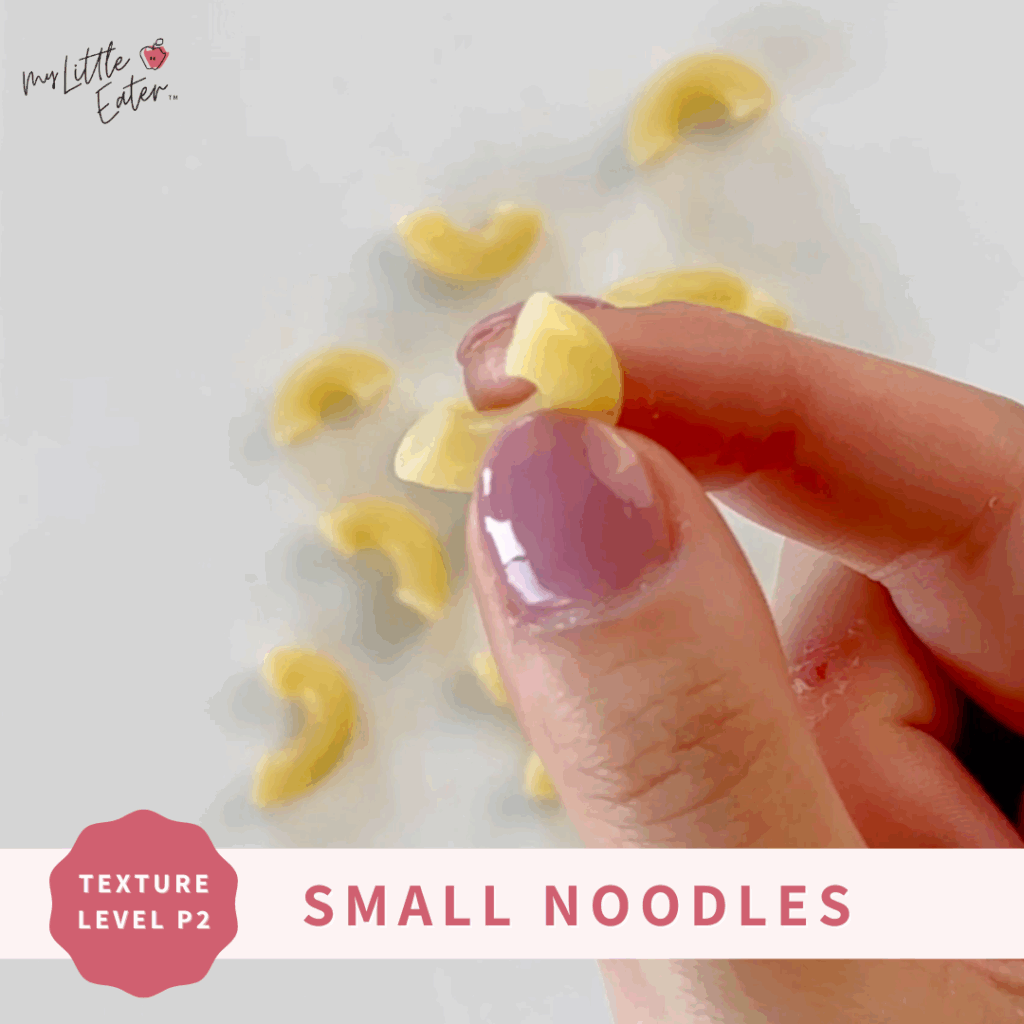
Serve small pasta noodles like elbow macaroni or mini shells on their own or with sauce. Your baby will be able to pick up the small noodles using their pincer grasp. You can also serve to baby on a spoon by mixing the small noodles in a puree.
Texture Timeline Phase 2
Long noodles (cut in thirds, with sauce) (Palmar Grasp)
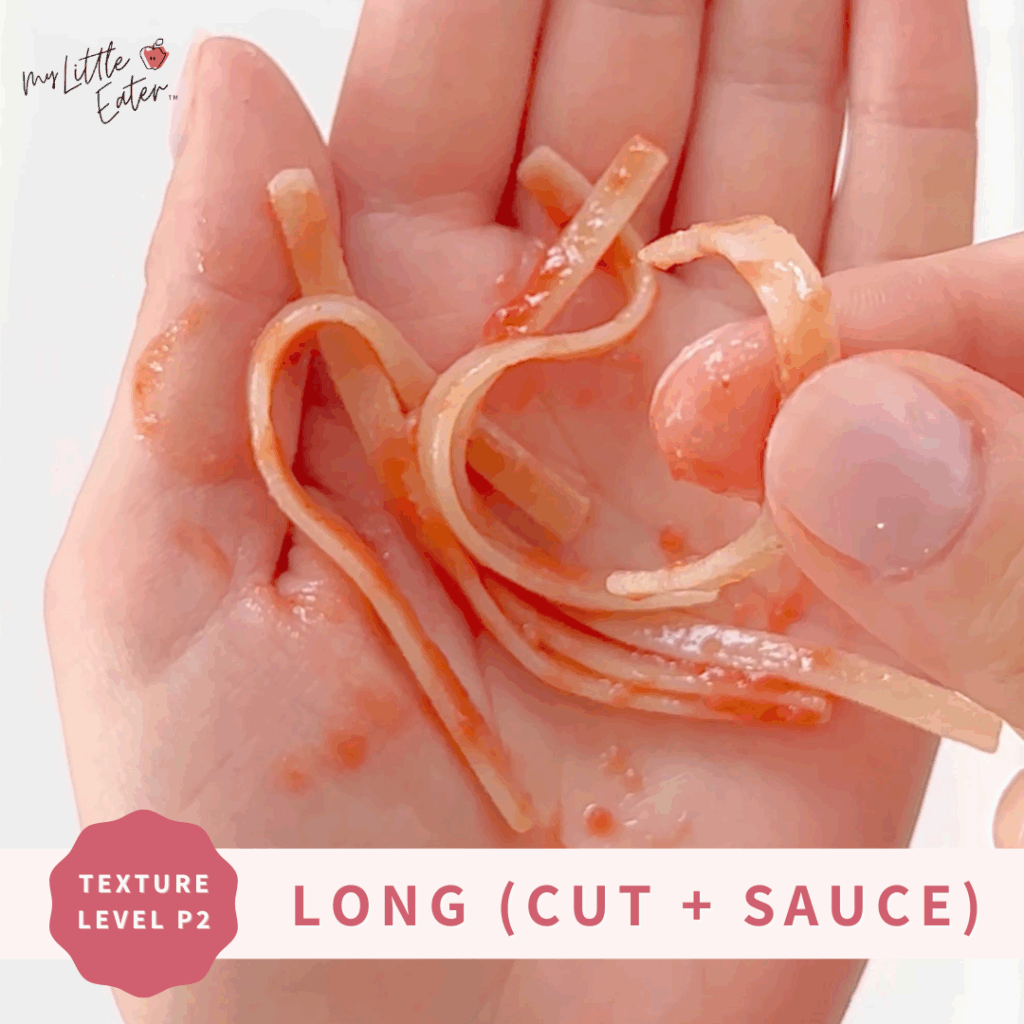
Long noodles like fettuccine or spaghetti can be cut into thirds to make it easier for your baby to pick up using their palmar grasp and to navigate and manage the noodles in their mouth. Add sauce, butter, or oil to keep the pasta noodles moist and easy to chew.
Texture Timeline Phase 3
Long noodles (uncut, with sauce) (Palmar Grasp)
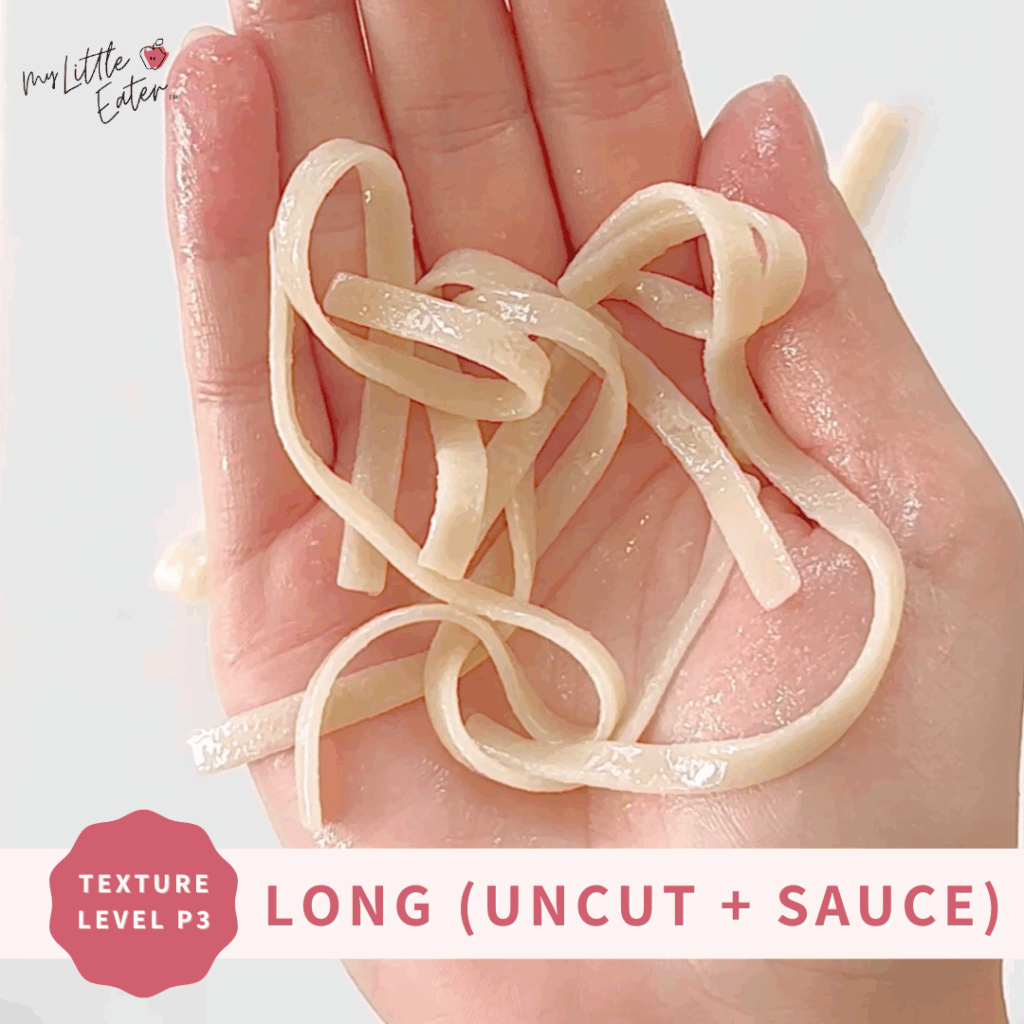
Long noodles like fettuccine or spaghetti can be served whole. You can serve them plain or with sauce, butter, or oil to keep them moist and easier to chew.
Nutritional benefits
Pasta is a high-energy food with lots of calories to offer! No matter which type of pasta noodles you choose (and there are many to choose from – we’ll get into that below), it will provide an abundance of carbohydrates, which convert to energy for your baby’s rapidly growing body.
Different varieties of pasta offer unique combinations of nutrients. For example, legume-based pasta (chickpea, lentil, and bean-based pasta) tends to be more nutrient-dense compared to pasta varieties made from wheat or rice flour, and contains higher amounts of:
- Protein: Required for your baby’s growth and for repairing and making new cells in the body.
- Iron: Needed for our red blood cells, which help to carry oxygen from the lungs to the rest of the body.
Babies and children absolutely need iron for their brains to develop normally. - Fiber: For gut health and digestion.
Healthiest pasta noodles for babies
You can offer any type of pasta noodles to your baby…egg or rice noodles, edamame pasta, veggie pasta, chickpea pasta, etc. No matter which type of pasta noodles you choose, they will provide an abundance of carbohydrates, which convert to energy for your baby’s rapidly growing body.
If you’re looking for the most nutrient-dense pasta option for your baby, some of the best options are edamame-based and bean-based pasta noodles for added protein, iron, and fiber, as mentioned above.
It’s important to note that the texture of lentil or bean-based pasta will be slightly more gummy when cooked fully, but still soft and safe for your baby. These pasta noodles also typically run at a higher price point, so if you’re looking for something more budget-friendly, choosing an egg noodle or whole wheat pasta is a great choice!
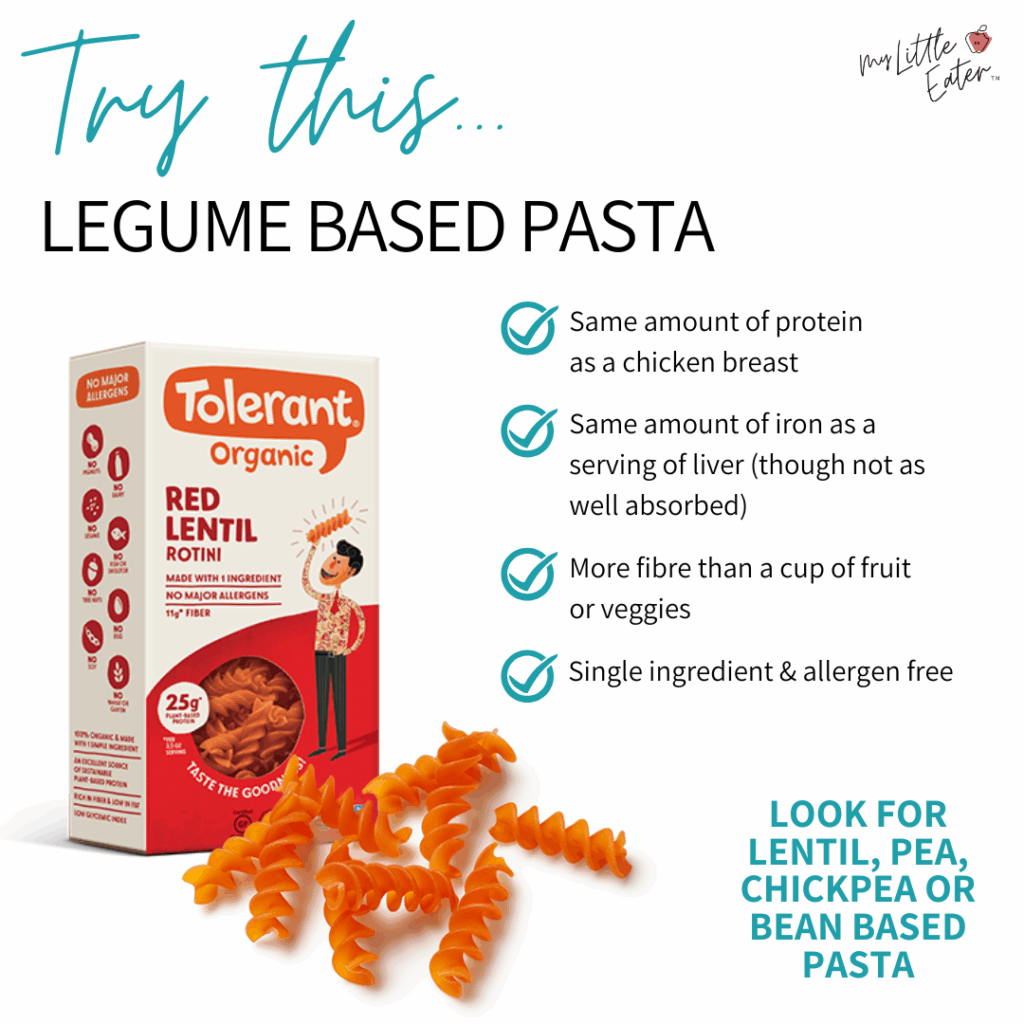
White pasta vs whole wheat
When buying traditional pasta noodles, you’ll typically be choosing between white or whole wheat.
Whole wheat or multigrain varieties of pasta are the more nutrient-dense pasta options when compared to white pasta varieties. They offer more fat, fiber, protein, and iron – all nutrients that are beneficial for a growing baby!
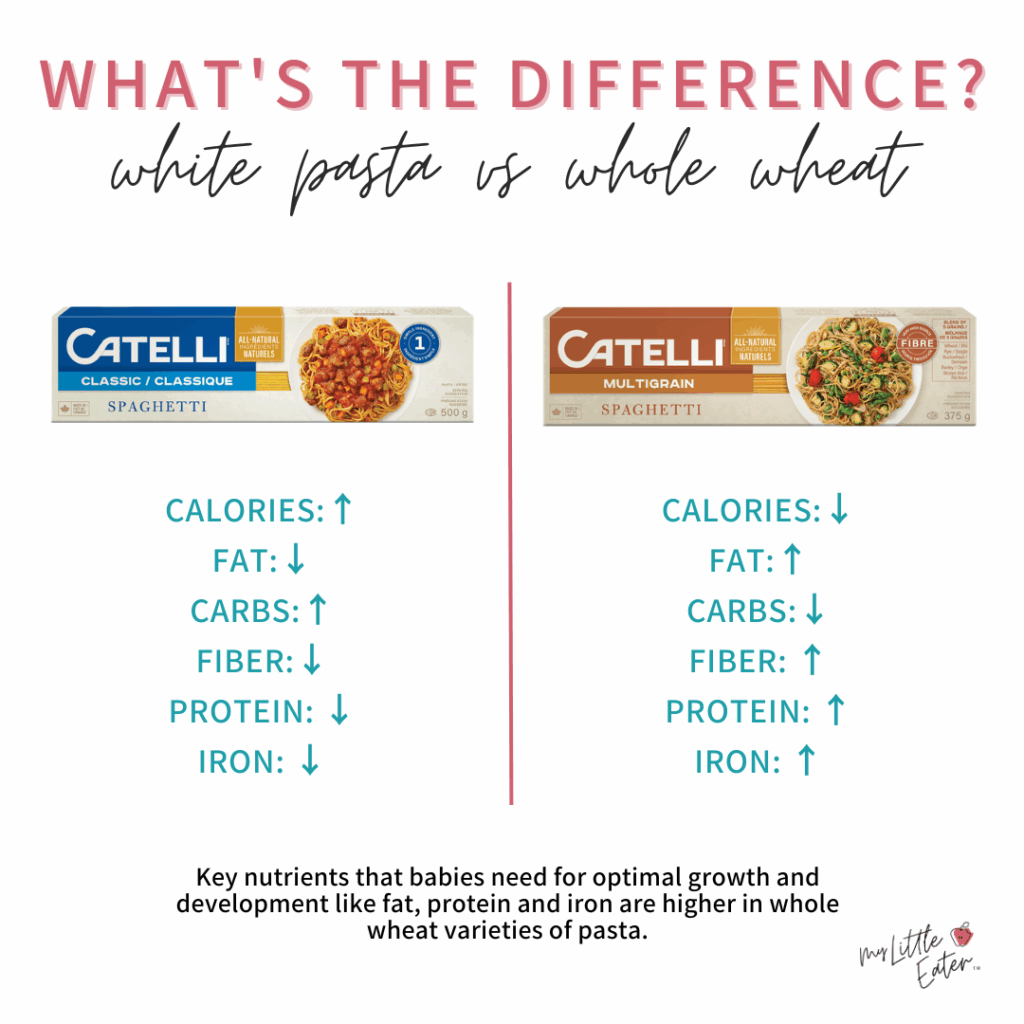
Nutritional comparison of different types of pasta noodles
When comparing the nutrient profiles of the various pasta noodle options available on the market to the most common “regular” pasta noodles made from wheat, you will see many variations in what each has to offer!
Screenshot the image below for your next trip to the grocery store, pin it to save for later, or click it to download it immediately and save it to your device!
Pasta brands used for nutrient comparison
- White pasta = Catelli classic
- Whole wheat pasta = Catelli whole grain
- Veggie pasta = Catelli super greens
- Chickpea pasta = Chickapea (organic spirals)
- Lentil pasta = Tolerant organic red lentil penne
- Black bean pasta = Explore cuisine organic spaghetti
- Edamame pasta = Explore cuisine organic edamame spaghetti
- Rice & Quinoa Pasta = GoGo Quinoa
- Rice noodles = Blue dragon
- Egg noodles = Blue dragon
Can babies be allergic to pasta?
Yes, pasta is typically made from wheat, which is one of the top 10 allergens recognized in Canada and the United States.
Since some varieties of pasta noodles contain both wheat and egg, we recommend first ruling out the possibility of one of these allergens before offering pasta noodles as a way to introduce the other allergen.

Being an allergenic food, it’s recommended you introduce pasta to your baby as early as possible after starting solids and keep offering it to your baby often (1, 2).
Learn more about introducing the top allergens to your baby.
Why you should serve your baby pasta
#1: Increases variety
Babies NEED exposure to a variety of foods early on, and with so many different colors and shapes of pasta noodles to choose from, it’s an easy way to add ample variety to your baby’s meals!
We need to introduce as many different foods (flavors and textures) as possible during the critical period between 6-9 months of age, while your baby is developing taste and texture preferences (2).
The more exposure a baby has to different foods during this time, the more likely they’ll accept these foods long-term and will more easily learn the skills to eat them.
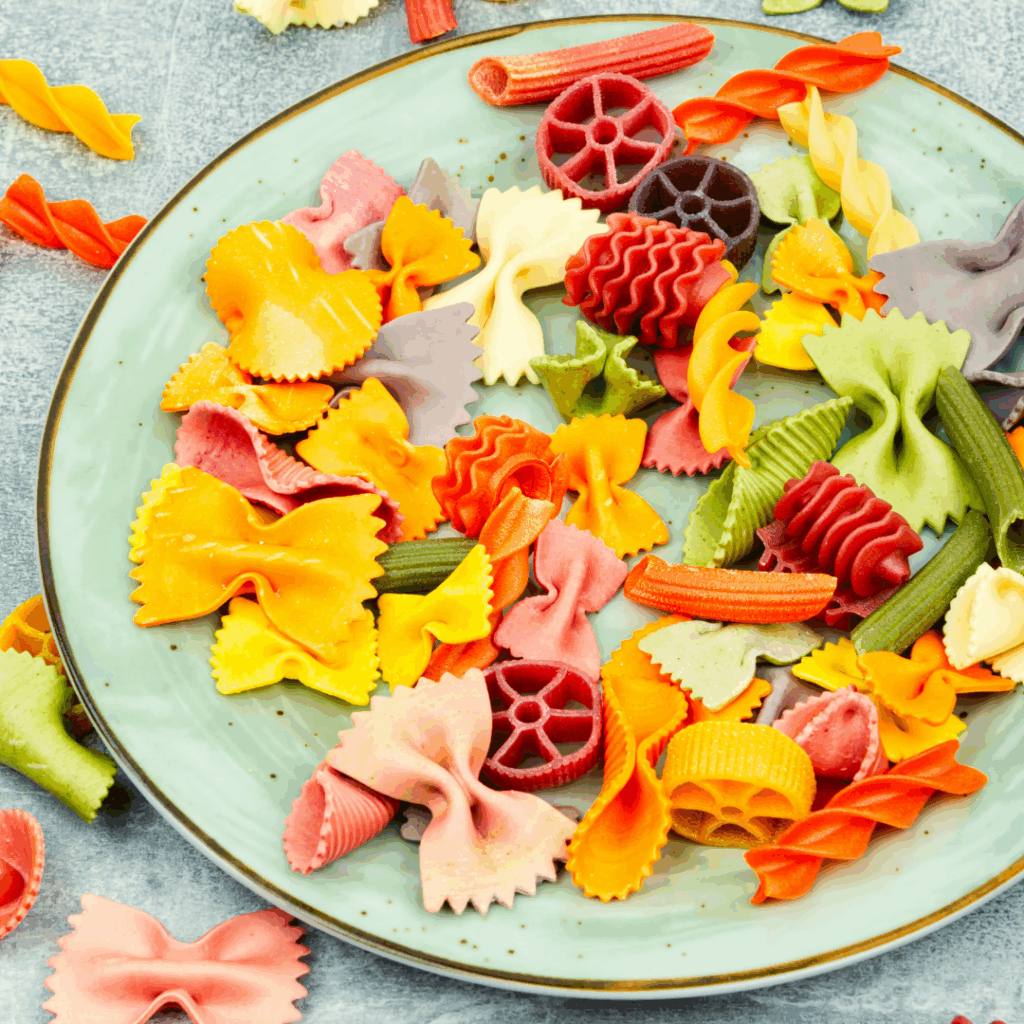
You can also change up the types of sauce paired with the noodles to further increase the variety of flavors and textures they’re exposed to during this time. For example, once your baby has some experience with smooth pasta sauces, try serving chunkier types of sauce for a new texture experience.
Our Texture Timeline™ video library inside the Baby Led Feeding Program allows you to search for any food and see exactly how to serve it based on different phases (difficulty levels) of the Texture Timeline™.
You get to see how your baby should be served the food based on their stage of development, and get tons of nutrition information on each food, plus allergy info, fun facts, and more! Get access to the video library below.
#2: Boost nutrition easily with various pasta sauces
Pasta noodles make an easy vehicle for all kinds of sauces! Pasta sauce can be used as a simple way to add nutrients to your baby’s meals while introducing them to new flavors.
When it comes to buying pre-made pasta sauces, there are some things to consider before you buy…
- Sodium and sugar content: Many store-bought pasta sauces can be high in sodium, and some also contain high amounts of sugar. While stressing about sodium isn’t as necessary as we once thought, it’s still important to be aware of it and limit it whenever possible because it does add up quickly. Added sugar we recommend avoiding until 2 years of age.
- Preservatives, chemicals, and unnecessary food additives: These are common in many store-bought, shelf stable products, so be on the look out for things like monosodium glutamate, sodium nitrate, and benzoic acid.
- BPA: Although most pasta sauces come in glass jars, there are canned options available. When buying canned products, aim to choose ones stored in a BPA-free liner and ideally, PVC-free lining as well.
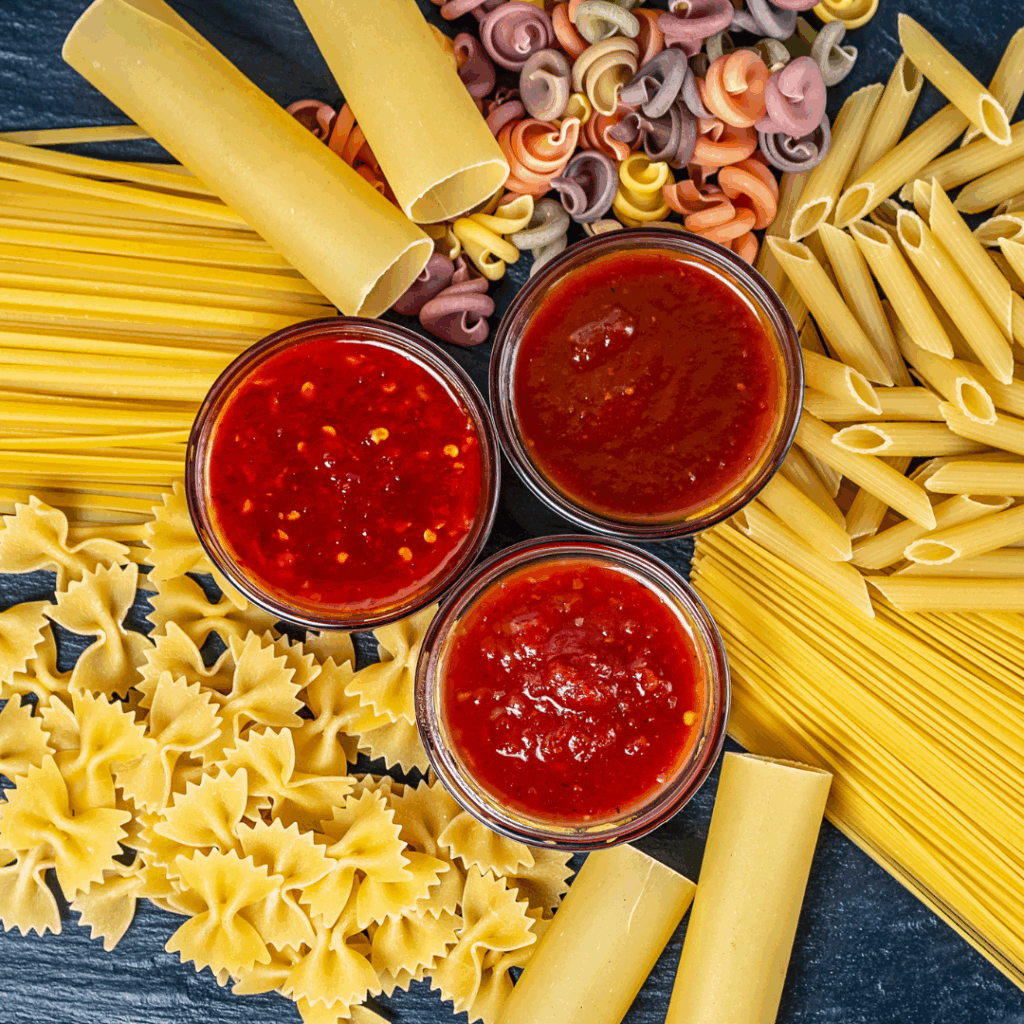
Making sauce at home is a great option – if you have the time! This way you can control the amount of salt and sugar and avoid unnecessary preservatives entirely. It can be as simple as blending up a few veggies – and voila – a nutritious pasta sauce for your baby.
We encourage you to add a variety of spices (basil, oregano, thyme, pepper, garlic, etc.) for your baby to get exposure to different flavors.
Top tip
Make large batches of various pasta sauces (like spaghetti sauce) and freeze them!
Perfect for those evenings when you need a quick and easy meal for the whole family!
- Pesto: A great way to introduce green veggies! Opt for homemade pesto if possible as store-bought pesto is usually high in sodium. You’ll find a simple, low-sodium pesto recipe below that’s perfect for the whole family!
- Marinara: Easy peasy, nutritious, and versatile. Be careful, as many store-bought marinaras can be high in sodium, so if you can’t make your own at home, you can also just do plain tomato sauce!.
- Olive oil: So easy, goes on top of any food, and is a great way to boost calories. You can substitute it for any other heart-healthy oil as well, like avocado or flaxseed oil.
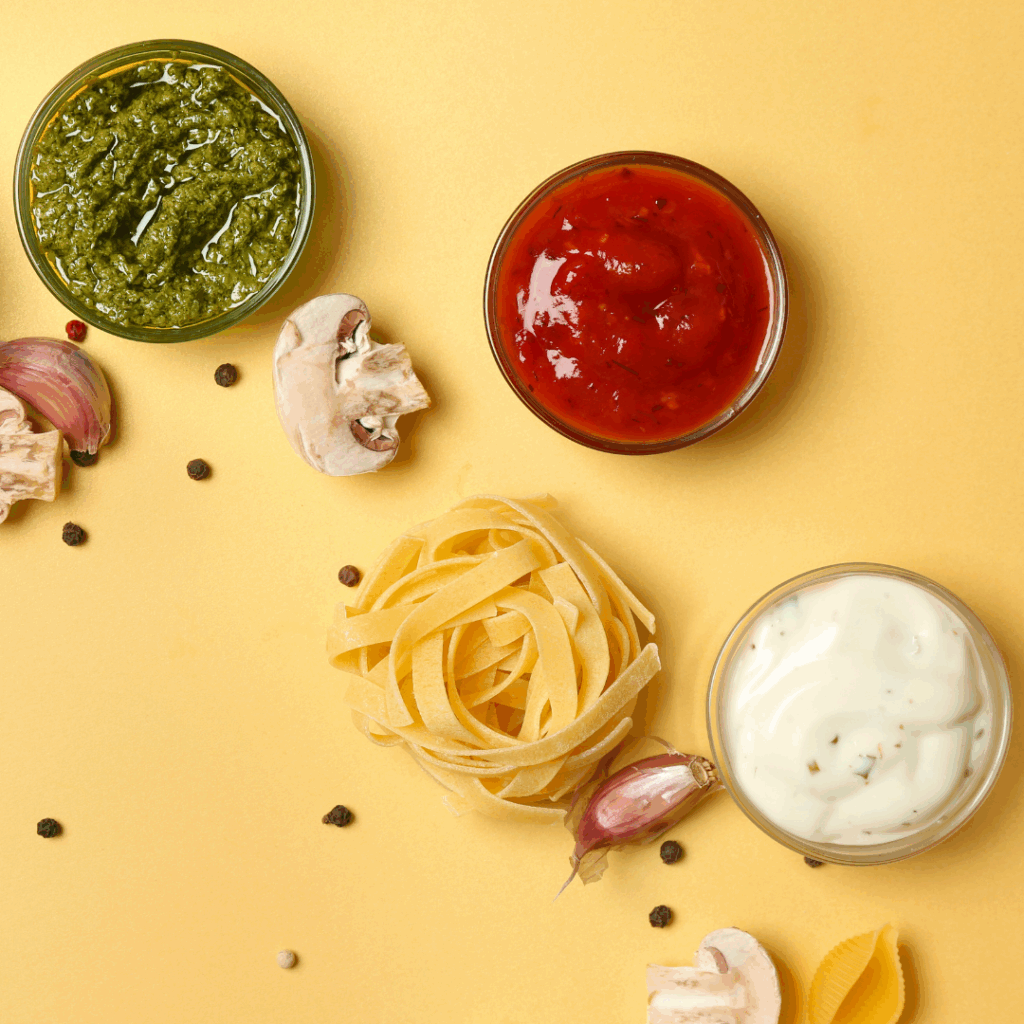
We know that there are lots of not-as-nutritious sauces out there, some of which may have very high salt content, and it can be difficult to choose the best option.
Luckily, Primal Kitchen has a huge variety of delicious, healthy alternatives to traditional sauces, condiments, and dips! All ingredients used are whole foods-based, with no added sugar, so you can’t go wrong.
Use code MYLITTLEEATER to get 10% off your purchase!

#3: Introduces a top allergen
As mentioned above, wheat is considered a top allergen. Highly allergenic foods are very important to introduce early on in your baby’s feeding journey to help prevent allergies from developing.
Learn more about the proper protocol for introducing allergens.
Note: It is ok to introduce other non-highly allergenic foods at the same time as introducing a top allergen. You just don’t want to introduce two or more top allergens for the first time at once. Learn more about why you don’t need to follow the “3-day wait rule” for non-highly allergenic foods.
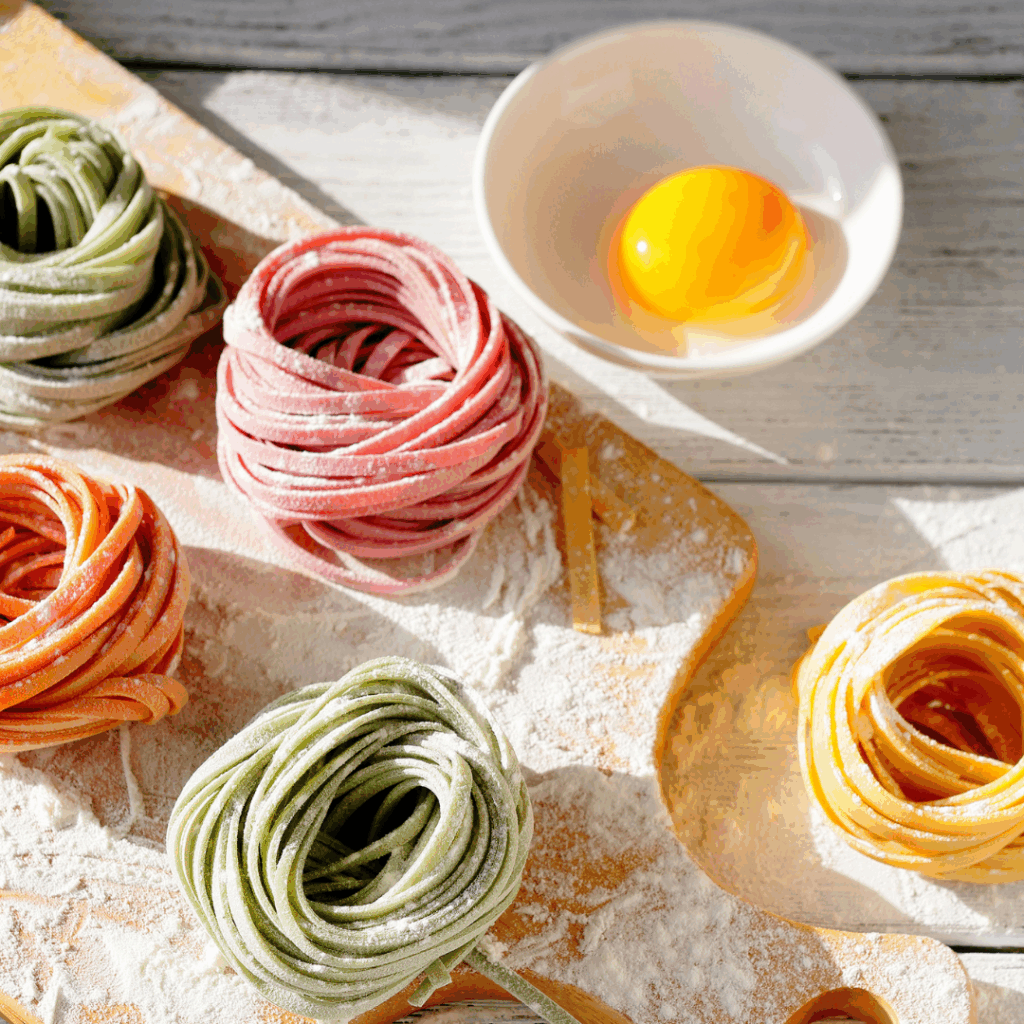
As you rule out top allergens, it’s important to keep offering them alongside other foods as well to lower the risk of food allergies developing later on. If there is no reaction, continue to feed the top allergenic foods at least 2-3x a week as you continue to introduce other foods.
Since pasta noodles are so versatile, it’s an easy food to serve multiple times a week. Simply changing the shape, sauce, or sides will ensure your baby is getting lots of variety while still being exposed to the allergen regularly.
#4: Use noodles to build a balanced baby plate
Offering a balanced baby plate at each meal is beneficial for making mealtimes more nutritious and flavorful, and it helps shape your baby’s taste buds early! Exposure to a wide variety of flavors can help your baby grow into an adventurous and curious eater in the future.
Pasta is the perfect fit for creating a balanced baby plate. It’s a high-energy food with lots of calories to offer, making it beneficial for your growing baby. Other high-calorie options include starchy foods like grains, starchy vegetables, and foods high in healthy fats.
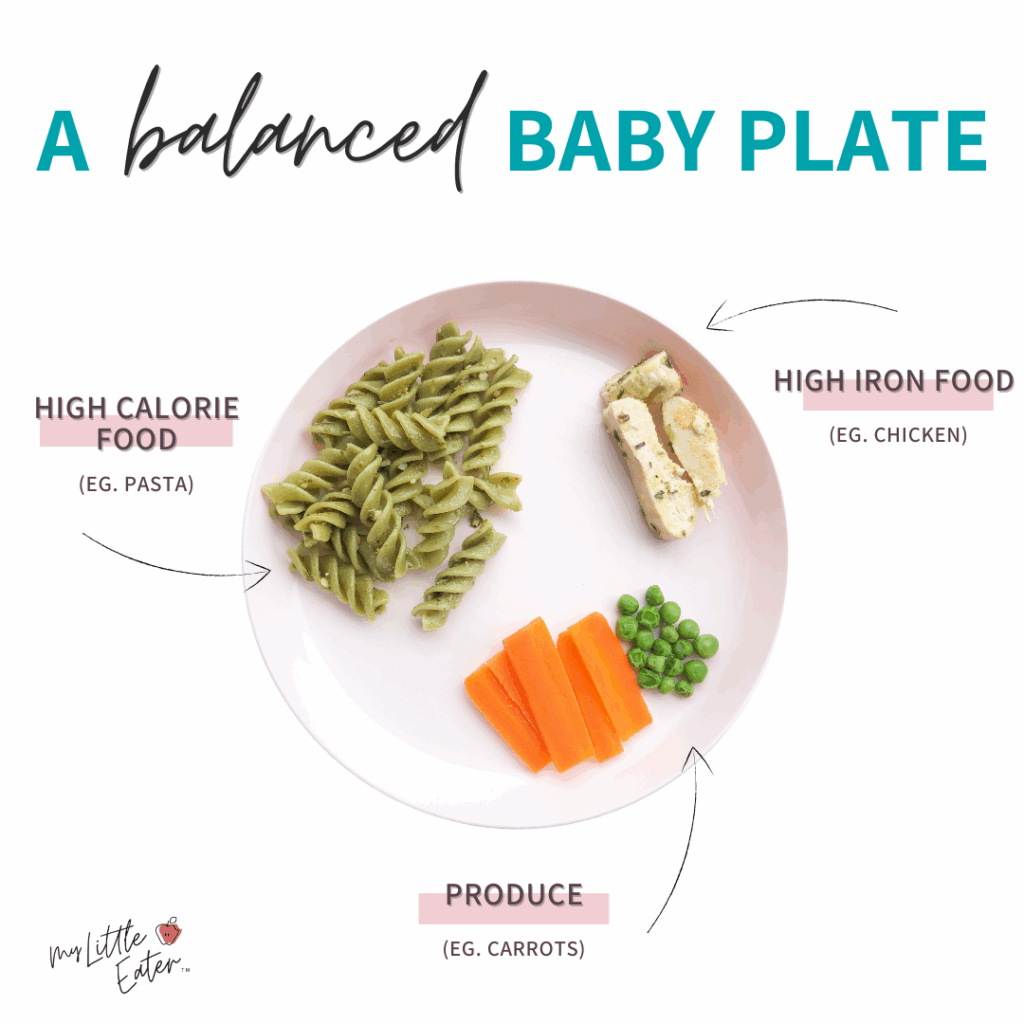
A balanced baby plate should also include a high-iron food from an animal source, like meat, poultry, and seafood, or a plant-based source, like beans, eggs, and tofu.
Last but not least, add produce to your baby’s plate to ensure continued exposure at every meal. It can also provide a source of vitamin C, which helps the body absorb iron from plant-based foods. Any fruit or veggie you can think of goes here!
#5: Pasta is easily modified for babies
For the most part, you want your baby to be eating the same meals as the rest of the family, which will be beneficial for exposing them to a wide variety of essential nutrients, textures, and flavors.
Including your baby in family meals gives them lots of opportunities to mimic you, which will actually help them learn how to eat! Not to mention, making one meal for the whole family is much easier and way less time-consuming than making separate meals for you and your baby.
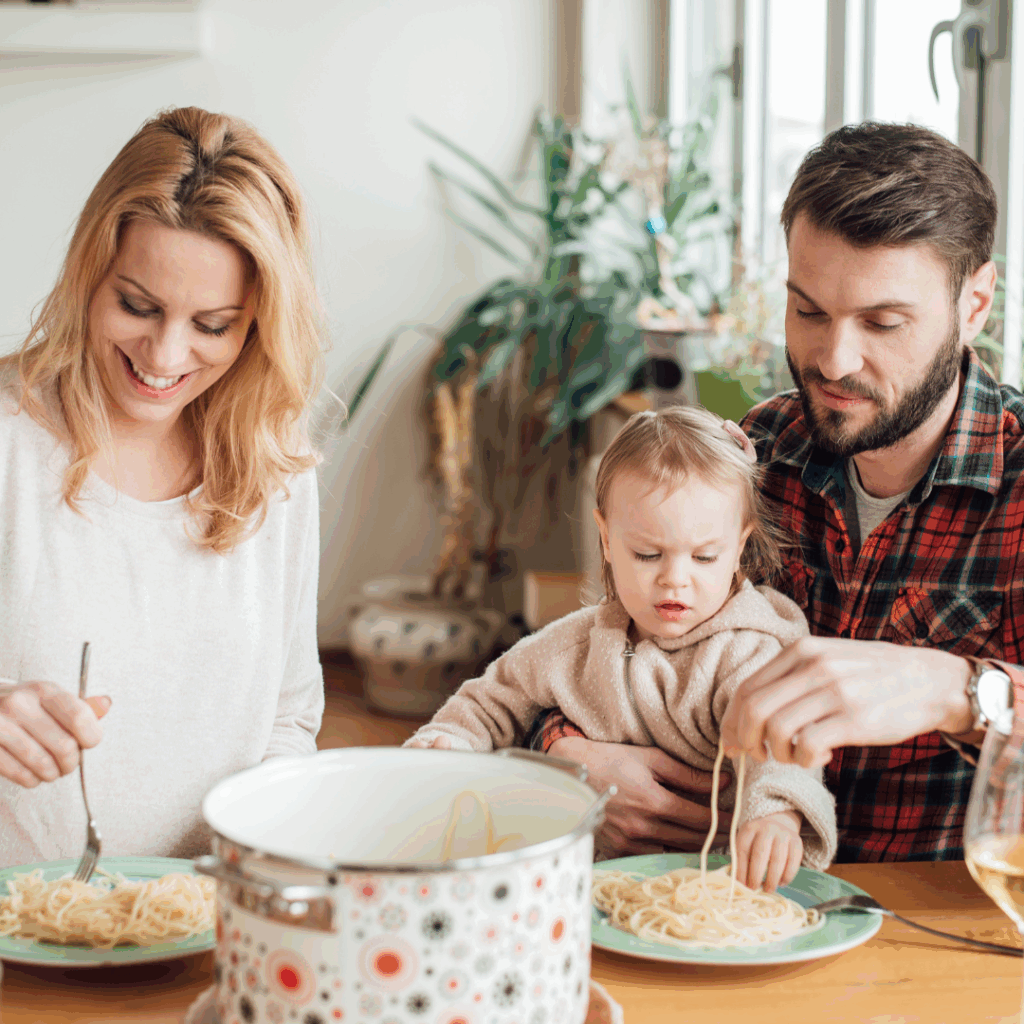
Refer to the “how to serve” section above for modifications to pasta noodles that are required for safety or to make them easier for your baby to eat.
Read more about how to modify other family meals safely to make them baby led weaning friendly.
Pasta FAQs
Should you overcook pasta for babies?
No, you don’t need to overcook it for it to be soft enough for your baby. Just cook it according to our steps above or package directions, ensuring it isn’t undercooked or too firm.
In fact, if you overcook the noodles too much, it can make it difficult for your baby to self-feed because they may squish the pasta too easily, breaking it into pieces and getting very little to their mouth.
Instead, keep pasta noodles soft and moist by cooking them according to directions and serving them with sauce – bonus points if the sauce boosts nutrition too!
Can babies have stuffed pasta?
Yes!
Options like stuffed ravioli are great for babies because they are still soft enough to pass the squish test, plus they’re typically big, which makes them easy for babies to hold.
If buying store-bought options, just be sure to check ingredients for other top allergens (since every allergen has to be introduced separately, and pasta already contains wheat) and salt content.
Is pasta good for babies, even if it's made with refined flour?
While pasta is made from refined flour, that doesn’t automatically make it “bad” for your baby (or for you). Refined flour means the outer bran and germ have been removed from the wheat grain. While this does lower the fiber content, here’s the good news…babies don’t need a lot of fiber for good health!
Fun fact – breastmilk actually has no fiber at all!
Plus, babies have excellent blood sugar regulation. When you follow our go-to formula for building a healthy baby plate —a high calorie food (like a starch or healthy fat) + a high iron food + produce—you naturally end up with a great balance of protein, iron, fat, and carbohydrates.
So when pasta is offered as part of a balanced diet, there’s absolutely no need to worry—it’s totally appropriate for babies!
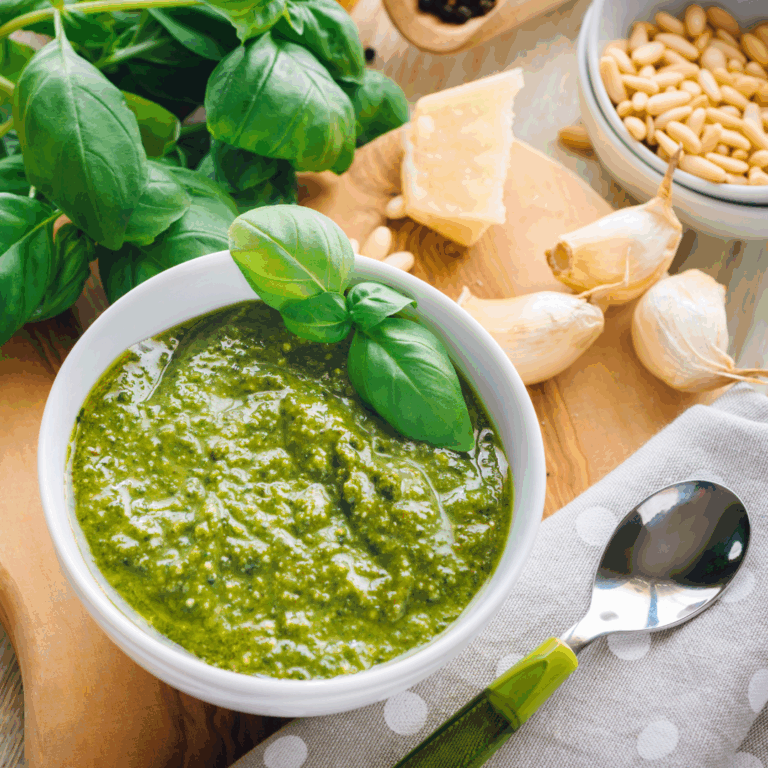
Easy Low-Sodium Pesto
Equipment
Ingredients
- 2 cups basil leaves
- ¼ cup pine nuts
- 2 garlic cloves
- ½ cup extra-virgin olive oil
- ¼ tsp salt
Instructions
- In a food processor, combine the basil, garlic, pine nuts, and salt. Pulse until smooth.
- While the food processor is running, slowly drizzle in the oil until fully incorporated. Enjoy!
Notes
Need more recipes? Check out our 60 Day Baby Led Feeding Meal Plan – you’ll get access to recipes, grocery lists, expert tips for starting solids, and more!
This isn’t just a regular meal plan with a list of recipes, you’ll actually be able to follow along with the plan to strategically introduce allergens, advance your baby in textures, and ensure all nutrient needs are being met.
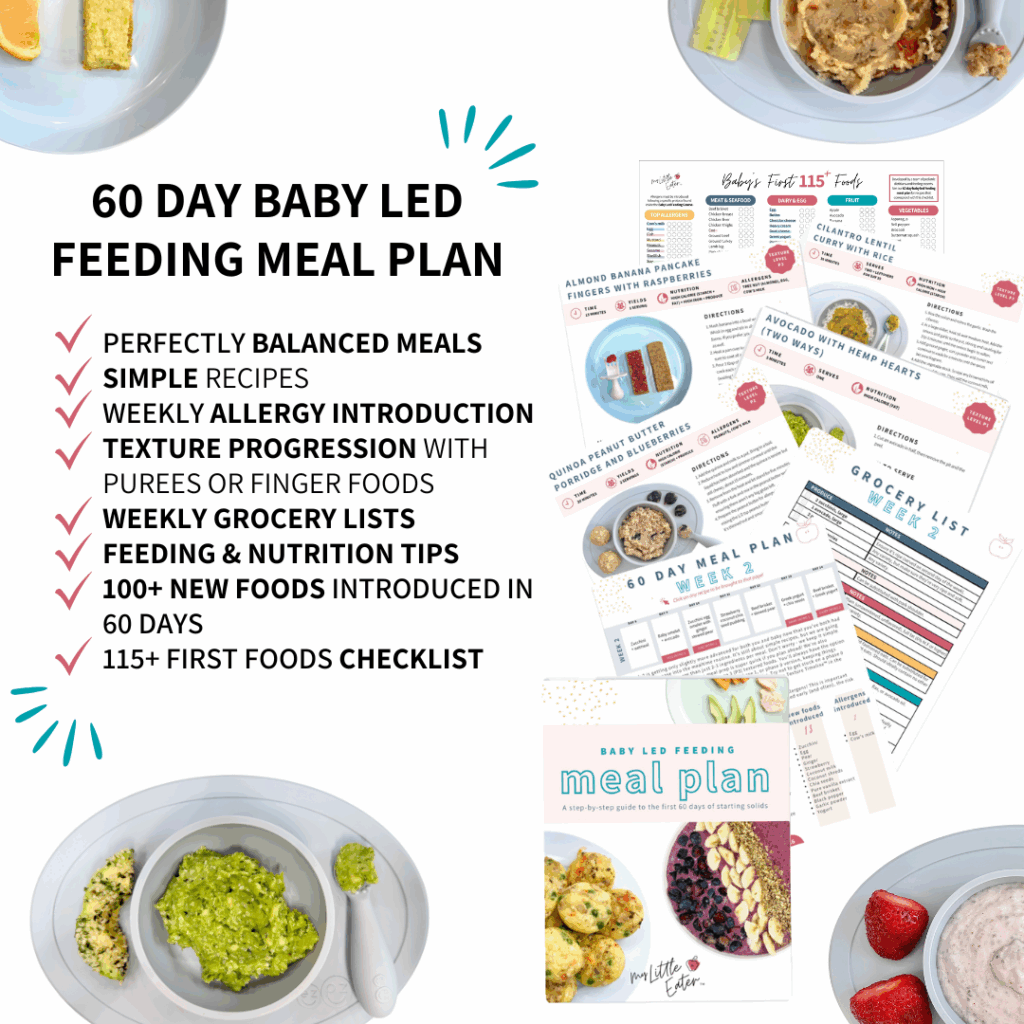
Love it? Pin it to save for later!
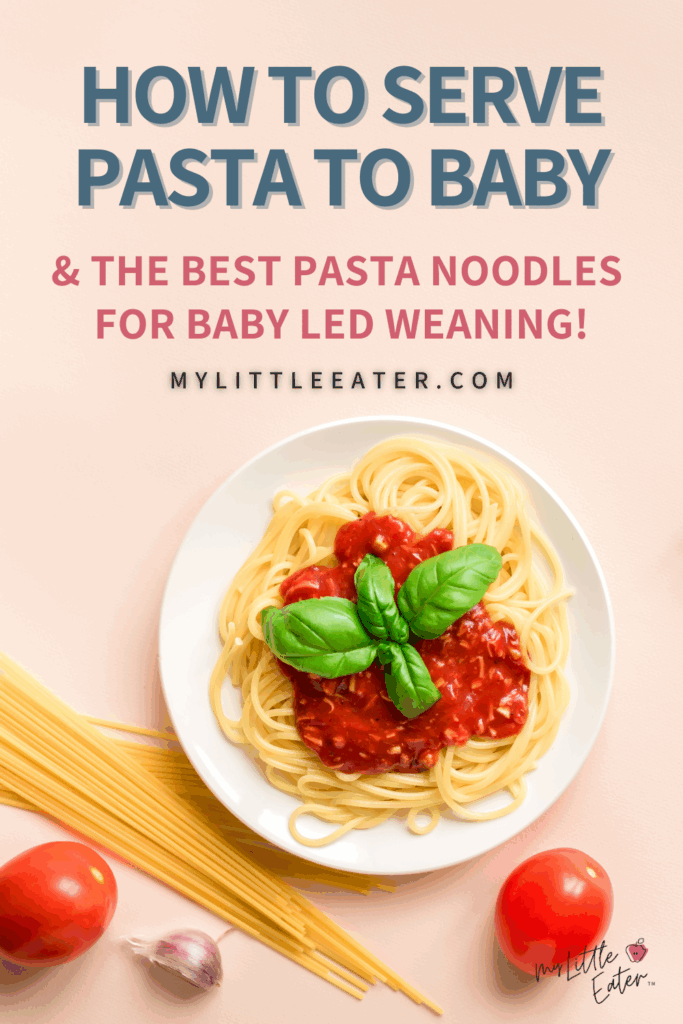
References
- https://www.thespruceeats.com/cook-pasta-perfectly-every-time-2014713
- Harris, G., Mason, S. Are There Sensitive Periods for Food Acceptance in Infancy? Curr Nutr Rep 6, 190–196, 2017. https://doi.org/10.1007/s13668-017-0203-0

CHELSEY LANDRY, RD
Community Dietitian at My Little Eater Inc., and bunny-mom to Hickory. Chelsey offers one-on-one counselling to parents of babies and toddlers that need more customized support. Learn more by booking a free discovery call with her today!

Chelsey Landry, RD
Community Dietitian at My Little Eater Inc., and bunny-mom to Hickory. Chelsey offers one-on-one counselling to parents of babies and toddlers that need more customized support. Learn more by booking a free discovery call with her today!

Bianca Gruenewald, RD
Bianca is a Registered Dietitian and works in a client support role at My Little Eater Inc. She's a proud auntie to her three year old niece and four year old nephew!

Bianca Gruenewald, RD
Bianca is a Registered Dietitian and works in a client support role at My Little Eater Inc. She's a proud auntie to her three year old niece and four year old nephew!
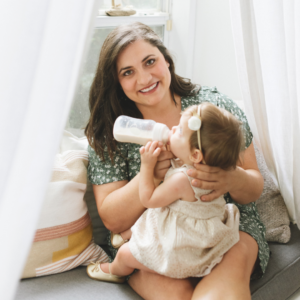
Mallory Roberts, SLP
Mallory is a Speech-Language Pathologist, Infant Feeding Specialist, and Craniosacral Therapist. She's also a busy mom of four little ones!

Mallory Roberts, SLP
Mallory is a Speech-Language Pathologist, Infant Feeding Specialist, and Craniosacral Therapist. She's also a busy mom of four little ones!
